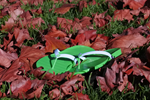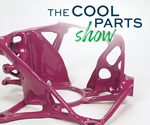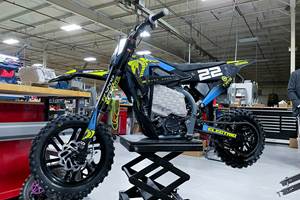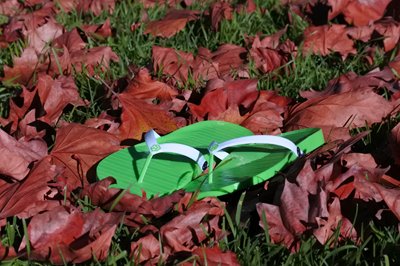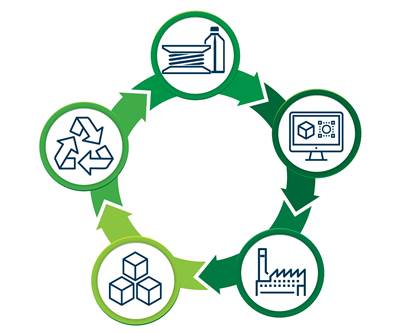What Do These Flip Flops Say About Manufacturing's Future?: The Cool Parts Show #21
These 3D printed flip-flops are an example of mass customization, but they also hint at manufacturing's more sustainable, circular future. Find out why in this episode of The Cool Parts Show.
Typical flip flops are made in two pieces: a foam sole, cut from a large piece of material with a die, and a plastic strap, made in an injection mold. Both of these parts require tooling, and are only available in a standard range of sizes because of the investment the manufacturer has made in that tooling. Retraction Footwear’s flip flops are different. While the company still uses the wearer’s size (or more accurately, foot length) as a base, it also accounts for foot width, arch height, weight and even personal taste. Every pair of flip flops is sized for its wearer and made to order, no tooling required, thanks to fused filament fabrication (FFF) polymer 3D printing.
But there is much more to understand and appreciate about these shoes. In addition to a mass customization option, Retraction Footwear represents one example of how 3D printing can aid and participate in the circular economy. Its sustainable model ensures that customers get exactly the shoes they want, but also uses material efficiently, reduces energy consumption and much more. | Season 3 of The Cool Parts Show brought to you by Carpenter Additive
The Cool Parts Show is a video series from Additive Manufacturing Media that explores the what, how and why of unusual 3D printed parts. Watch more here.
Have a cool part to share? Email us.
Resources and links
Transcript
Stephanie Hendrixson
In this episode, we'll talk about these 3D printed flip flops. But it's about more than footwear. These shoes tell the story of the future of manufacturing. Welcome to The Cool Parts Show.
Pete Zelinski
Season 3 of The Cool Parts Show is brought to you by Carpenter Additive. The company's Athens, Alabama Emerging Technology Center is an end to end additive manufacturing production facility with everything from material development, to post processing under one roof, ready to help you with your next metal 3D printing job. Check them out at Carpenteradditive.com. Now back to the show.
Pete Zelinski
I'm Pete.
Stephanie Hendrixson
I'm Stephanie.
Pete Zelinski
We are with AdditiveManufacturing.Media.
Stephanie Hendrixson
And this is The Cool Parts Show our series all about cool, unique and awesome 3D printed parts.
Pete Zelinski
We are at the end of season three, we've seen lots of awesome 3D printed parts. And Stephanie, you've got a big cylinder in front of you.
Stephanie Hendrixson
Yeah. So this contains our last cool part of the season. So we are social distancing right now. So I'm just going to toss you one of these. All right. This is our season finale. What do you think?
Pete Zelinski
Like it? I'll say we've done footwear already. Right?
Stephanie Hendrixson
Yes, we have done footwear before. But we are going to do it in a different way today. So do you remember at the beginning of this year, the beginning of 2020, you walked in my office and you gave me an assignment for the year?
Pete Zelinski
Yeah, I do. So you were just about to start work with one of our sister brands on an article that had to do with recycling, sustainability. Sustainability, a promise of additive manufacturing that up till then we hadn't really looked at in a really focused way. And you ran with that. And in fact, you ran so far with that, ultimately, we were able to put out an issue of the magazine entirely devoted to sustainability, the circular economy,
Stephanie Hendrixson
Right. And so, in, in working on that assignment, I really quickly learned that sustainability is a lot more than recycling. There's this whole idea of the circular economy that you just mentioned, which is this idea that we should take our resources and use them responsibly, keep them in play for as long as possible. And then when something wears out, you know, you should recapture that material and feed it back into the cycle. And so we're going to talk about these shoes today, because they are an example of that. This is the circular economy, a closed loop from beginning to end. And it's not just about manufacturing. So you know, the implication here is that we don't have to stop buying and making new goods, we can keep consuming, but we have to be more conscious of what happens to products at the end of their lifecycle.
Pete Zelinski
Okay, so I'm, I'm with you tell me about these flip flops. Tell me how they close the loop.
Stephanie Hendrixson
Okay, so these are custom 3D printed flip flops. They're made with an FDM process, fused deposition modeling. They are produced by a company called retraction footwear that's in Australia. So the founders name is Brett Casson he is an engineer. Actually was working in the construction industry but he got into 3D printing as a hobby. And I'll let him explain why he started a footwear company.
Brett Casson
Yeah, well, I started Retraction Footwear, mainly because I have always loved making things and solving interesting problems. It struck me that additive manufacturing, one of its real strengths is its ability to customize. I think nowhere is that more important than when the human body is involved. And the more I thought about it, the more it seemed crazy that everyone's got different feet, but we're forced to choose from maybe a dozen standard different sizes. So I've always worn flip flops or thongs as we call them in Australia. And while I love their simplicity and their convenience, the fact is they're not great for your feet. Starting a 3D printing company with making flip flops combined two of the things that I loved and gave me the opportunity to make something that I thought would be significantly better than what was currently available.
Pete Zelinski
So Stephanie, I think you're wearing Australian 3D printed flip flops right now.
Stephanie Hendrixson
I am indeed. Yes.
Pete Zelinski
Okay. So then you probably have an opinion about all of this. I confess, I haven't thought about flip flops in that way before. So you elaborate what are the problems with flip flops?
Stephanie Hendrixson
Well, so there's a couple of problems but I think kind of the big one here is the issue of size. So we all kind of walk around with this number in our head of what our shoe size is, but it's not exactly accurate. So like I for instance, my feet are seven and a half ish. If I'm buying something where I know I'm gonna wear socks or something, you know, sometimes I go up to an eight. If I'm buying a sandal like I might go down to a seven. And you just don't actually have that many choices, you know, there are these 12 or so standard sizes, and you can sort of choose between them, maybe you get the option of a wide or narrow, but it's often a compromise when you're shoe shopping. And it's often the case that you encounter some shoes that you have to leave on the shelf, they're just never going to work for you in any size or configuration that's available.
Pete Zelinski
So I'm listening, and you're talking about sizing. And again, we've done the issue of mass customization specifically focused on footwear. And you wouldn't be taking us here again, if there wasn't more to say about it, or something different to say about it here. So play that out a little bit more take us there.
Stephanie Hendrixson
Right, so we've been talking about size, but size is not equivalent to fit. Size is really just expressing the length of the shoe, right. And then there are all these other factors that actually go into how the shoe fits you. So for Retraction, it's not a scan process, like we've talked about previously, it could be one day, that's something they're they're interested in. But right now, it's a series of drop down menus when you order these shoes. And so you have the choice of size of length, but you also have different widths that are laid out in centimeter measurements. So you have a much better idea of what size shoe you're getting. You also have the option of different supports based on whether you have high arches, flat feet, kind of average. You can put in your weight and that also influences the support. And you get to choose the colors, you get to choose the strap and the footbed and the sole on the bottom.
Pete Zelinski
Drop down menus, with lots of options. Why can't we have that today? Why can't today's flip flops give us that kind of variety.
Stephanie Hendrixson
So I'm glad you asked. So if you think about a standard flip flop, it's a piece of foam and a plastic strap. This foam would be cut with the die cutter out of a larger piece of material, the strap would be injection molded. And so for both of those processes, you need tooling. And if you're gonna make the investment in tooling, you want to buy as few tools as possible and just make a whole bunch of parts that way. So we're locked into these standard sizes, again, because of tooling.
Pete Zelinski
And I know that there's a macro economic issue to all of this, and you want to take us there and I want to go there, but I'm really not done with the flip flops yet. Okay, so these are 3d printed. And we know something about 3d printing is you're controlling geometry outside and in. Let's talk about in. If I cut this open what would I find?
Stephanie Hendrixson
Yeah, so depending on how you answer, the weight range question and the arch support question, the inside of your shoe is going to look different. So here's Brett describing what happens on the inside,
Brett Casson
You can see the amount of cushioning and air pockets within it. These air pockets, we can customize the size of them to suit the wearer's foot size and their weight to give an optimal mixture of cushioning and support. Adjusting the amount of support inside an item of footwear is a pretty revolutionary concept, especially in a thong or flip flop, but it's something that we think is important to maximize user comfort.
Pete Zelinski
All right, so I think we're ready now. Why don't you go global, you kind of connected this to the circular economy, how is this flip flop the future of manufacturing.
Stephanie Hendrixson
Okay, so if you think about how flip flops are typically made, this is two different materials probably made in a large factory, probably assembled together by hand. And this is the classic linear economy, you know, we take resources, we turn them into products, we sell those products, and then at the end of their life, they get thrown away. So there's like a clear beginning and end.
And then when you look at what Retraction is doing, it looks much different. So starting first off with the material, so this shoe is flexible TPU. And the whole thing is the same material. So right off the bat, this is easier to recycle, because you wouldn't have to separate anything, any part of it out. It's made specifically for the user. So it's made not just to the size of the wearer, it's made to fit them exactly. And so these are made on demand. They don't produce any extra shoes. And so you don't have issues with inventory, you don't have any extra stock that's going to get thrown away when the season changes or when styles change. And the manufacturing process itself is more sustainable. So you have instead of a big factory, Retraction is able to make these with just a dozen desktop printers, so much smaller facility, and it's a more energy efficient process. So they've actually optimized their printers so that each one only uses about the same amount of electricity as a light bulb.
These are printed without support structures. So you don't have that waste in the process, you're not trimming anything off. And just for comparison, these are both my shoes. But the conventional one has so much extra material. And so like you're even eliminating the waste in the end product itself. But we've been talking about this whole issue of the circular economy and these shoes from Retraction, they close that loop because when you are done with the shoe or something happens to it, you can actually ship it back to Retraction Footwear, and they will grind it up, turn it into filament and make new shoes out of it.
Pete Zelinski
Okay, so I get it, I'm there with you. And I see why this shoe is so important and why it's worth going back and doing footwear again. Because in AdditiveManufacturing.Media, we've looked at these issues but we always get the chance to do just one of these issues at a time, right. We talked about products that are made to be more efficient, or we talked about different modes of manufacturing and different types of factories that are more eco friendly, or we talked about recycled material, but it's always just one piece or another. Here's maybe the first product and maybe the first of many products to come that's an example of putting all those pieces together, the entire loop.
Stephanie Hendrixson
Yeah. So when you gave me that assignment at the beginning of the year, like this is the story I've been looking for. I was so excited when Brett reached out, because, you know, this looks like kind of a simple part but it represents so much about manufacturing. And I think there's one other aspect of about this that we should address.
Brett Casson
One of the major issues facing the footwear industry is waste. It's estimated around 20 billion pairs of footwear are made every year using traditional methods and traditional methods are a subtractive process so you end up with off cuts. It's estimated that can be up to around 15% of the total material used, which when you sort of extrapolate it out and ended up to quite a lot. 3D printing is an additive manufacturing process so we're only using the material where it's made 89 waste. One other benefit that we have is that traditionally, footwear companies offshore the manufacturing, which means basically only made to do things in large runs
Stephanie Hendrixson
So when you stop thinking about shoes as this kind of 12 standard sizes made from larger pieces of material and large factories, and you start thinking about them as more digital custom products. You can change you know how the supply chain works. So instead of centralized factories that are producing shoes and shipping them all over the world, if you're 3D printing these can you put 3d printers in different parts of the world? You know, we saw that kind of with the coronavirus pandemic that it was difficult to get goods from different places. And a model like this where you just need a desktop printer could result in shorter, much more reliant supply chains.
Pete Zelinski
Okay, so that's a lot. Okay, so I'm in. Like this flip flop has a lot to say and a lot to teach us. Okay, let me see if I've got all this. 3D printed flip flop. So this is made, not literally customized to every individual but with so many options in sizing and selecting it that you can get exactly the flip flop that you want. This manufacturing process allows the chance to wait until the consumer actually orders it to produce as needed, produce in precisely the quantity required because the end user tells you what quantity they want. So then in addition to that it's an energy efficient production process. Very low footprint manufacturing equipment. These 3D printers that fit on a desktop take up very little space very tiny factories. And just adapted even to be more energy efficient still. I think you said that just the energy output of a light bulb is what each of these 3D printers requires.
And then where they're going next is fully completely closing the loop because Retraction Footwear has a plan to accept back flip flops that the user is all done with so that they can be ground up, reclaimed, used in brand new flip flops produced later. Completely closing the loop in the circular economy. So what this shoe shows is sustainability at all the steps of how you think about a product, sustainable design, sustainable production quantities, sustainable production hardware and a sustainable strategy for end of life.
Stephanie Hendrixson
Thank you for watching season three of The Cool Parts Show. We're gonna go on hiatus for a little bit but we'll have some other special episodes coming to you in the meantime. Make sure you're subscribed so you don't miss any of our new content.
Pete Zelinski
If you're new just seeing this for the first time, we'll be back but in the meantime, go watch all of our existing stuff season one, season two, special episodes, TheCoolPartsShow.com. Thanks for watching.
Thank you to our sponsor Carpenter Additive. Listen to additive manufacturing podcasts, attend webinars and learn more at CarpenterAdditive.com
Related Content
Additive Manufacturing Is Subtractive, Too: How CNC Machining Integrates With AM (Includes Video)
For Keselowski Advanced Manufacturing, succeeding with laser powder bed fusion as a production process means developing a machine shop that is responsive to, and moves at the pacing of, metal 3D printing.
Read MoreNew Electric Dirt Bike Is Designed for Molding, but Produced Through 3D Printing (Includes Video)
Cobra Moto’s new all-electric youth motocross bike could not wait for mold tooling. Parts have been designed so they can be molded eventually, but to get the bike to market, the production method now is additive manufacturing.
Read MoreAluminum Gets Its Own Additive Manufacturing Process
Alloy Enterprises’ selective diffusion bonding process is specifically designed for high throughput production of aluminum parts, enabling additive manufacturing to compete with casting.
Read MoreLarge-Format “Cold” 3D Printing With Polypropylene and Polyethylene
Israeli startup Largix has developed a production solution that can 3D print PP and PE without melting them. Its first test? Custom tanks for chemical storage.
Read MoreRead Next
Retraction Footwear Is the Sustainable Manufacturing Business of the Future
Retraction Footwear offers a new way of buying flip-flops that are made to suit each customer. But the company also represents a new way of thinking about production, in a circular economy loop that encompasses material, design, manufacturing, product and end-of-life.
Read MoreAdditive Manufacturing Will Aid And Accelerate The Circular Economy
A circular economy links material, design, manufacturing, product and end-of-life in a continuous, sustainable loop. This special report illustrates the roles for 3D printing every step of the way.
Read MoreGenerative Design Improves Micromobility FUV: The Cool Parts Show #19
Arcimoto’s lightweight “Fun Utility Vehicle” gets even lighter thanks to parts that could only come from additive manufacturing. On this episode of The Cool Parts Show, some of the craziest automotive parts you have seen.
Read More
.jpg;width=70;height=70;mode=crop)
